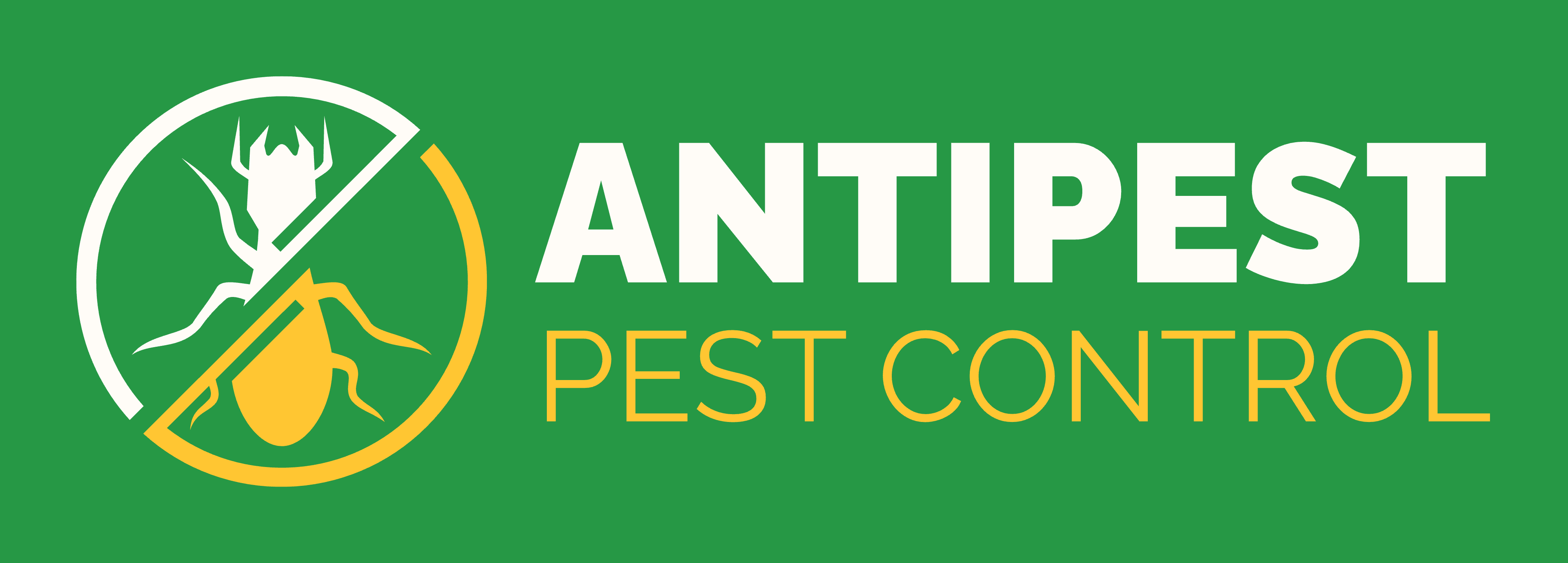Gnats are among the most frustrating household pests, buzzing around your face, your food, and your plants. If you’ve been wondering how to get rid of gnats, you’re not alone. Millions of homeowners battle these tiny pests every year in kitchens, bathrooms, and gardens. Whether they’re breeding in damp soil, rotting fruit, or drain pipes, getting rid of gnats requires a mix of prevention and control methods.
By the end of this guide, you’ll know multiple strategies to stop infestations, keep your home gnat-free, and prevent these pests from coming back. Let’s break down exactly how to get rid of gnats efficiently, using practical solutions that really work.
Table of Contents
What Are Gnats?
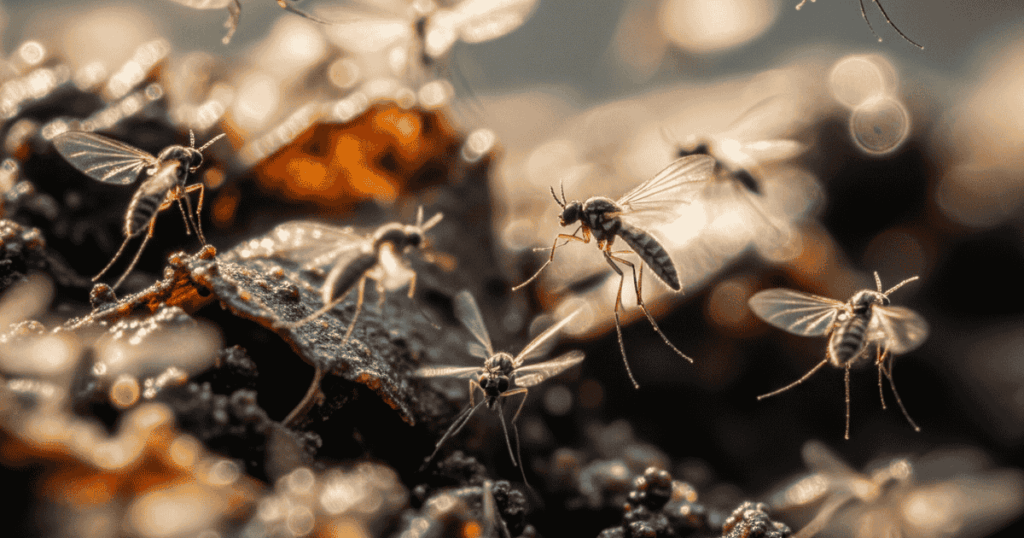
Gnats is a term that describes various small flying insects, including fruit flies, fungus gnats, and drain flies, that are notorious for gathering in homes and gardens. Understanding their behaviors and preferred habitats is the first step in mastering how to get rid of gnats. These pests measure only a few millimeters and possess slender bodies, delicate wings, and long legs. Gnats lay eggs in the environment, and the larvae feed on organic materials in soil, decaying food, and moisture-rich places.
While harmless in small numbers, gnats can quickly breed into large populations, leading to swarms that interfere with daily life, damage houseplants, and contaminate food. Knowing the core biology and habits makes efforts at how to get rid of gnats far more successful.
Gnats are often confused with other flying pests, but a closer inspection reveals key differences.
Common Types of Gnats
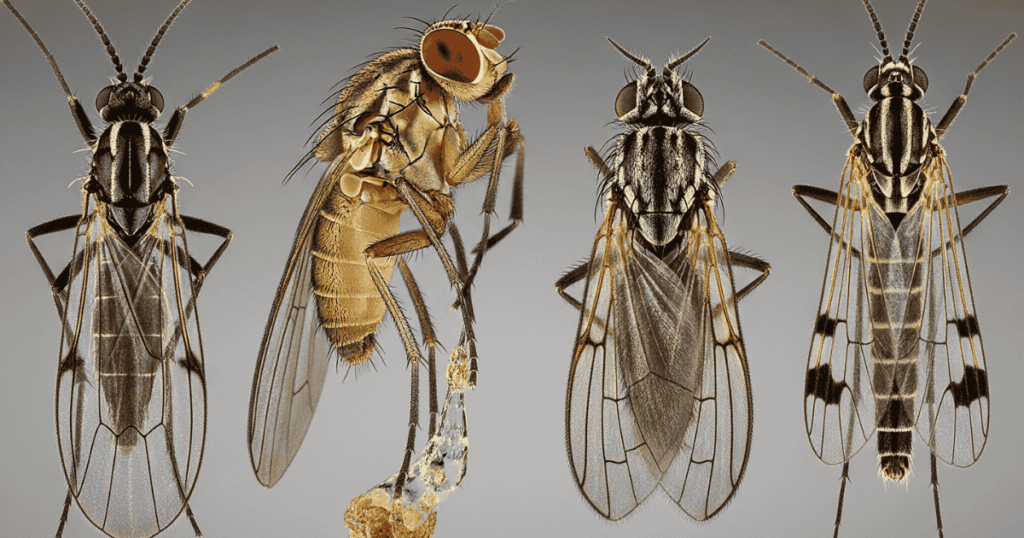
Knowing the kind of pest you’re seeing is crucial for how to get rid of gnats quickly and decisively. The most common types indoors and outdoors are:
- Fungus Gnats: These are slender, dark insects with long legs. They’re mostly found around moist plant soil or garden beds, laying eggs in damp organic matter.
- Fruit Flies: Smaller and usually tan or brown, with prominent red eyes. They congregate around ripe fruit, vegetables, and sugary liquids, common in kitchens and pantries.
- Drain Flies: These breed in wet drains and plumbing areas, resembling tiny moths.
Understanding each pest’s preferred habitat and breeding patterns leads to targeted strategies for how to get rid of gnats.
Gnats at a Glance
| Gnat Type | Appearance | Habitat | What Attracts Them | Breeding Ground |
| Fungus Gnats | Slender, dark | Plant soil, garden beds | Dampness, organic matter | Soil |
| Fruit Flies | Tan, red eyes | Kitchens, trash cans | Overripe fruit, sweet spills | Rotting food |
| Drain Flies | Small, fuzzy | Bathrooms, sinks | Standing water, residue | Wet drains |
What Attracts Gnats?
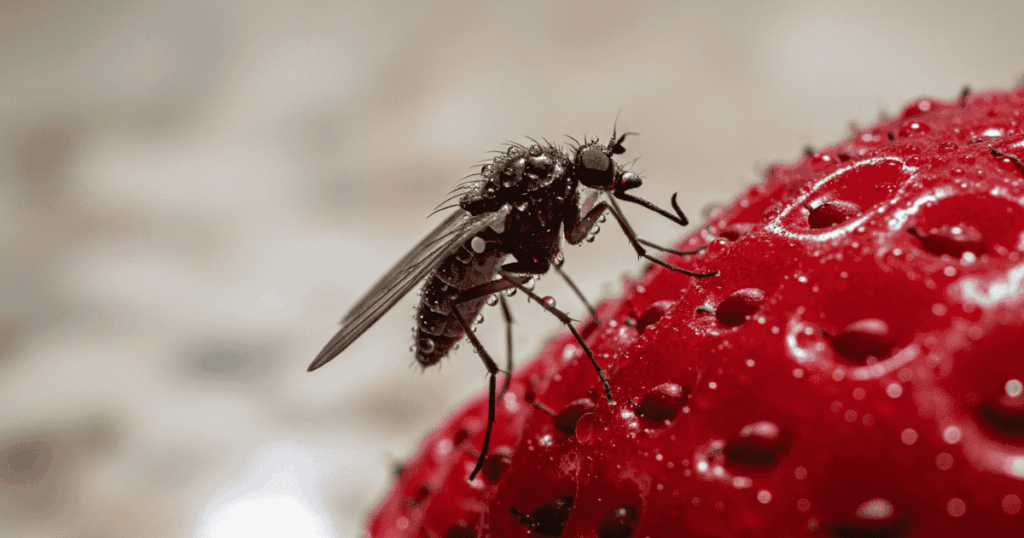
Gnats are opportunistic insects. They go wherever conditions are optimal for feeding and breeding. Knowing what attracts gnats will help you avoid future infestations and perfect how to get rid of gnats.
- Decaying Fruit: Ripe bananas, peaches, and grapes are irresistible to fruit flies.
- Wet Soil: Overwatered plants and stagnant garden beds bring fungus gnats.
- Sugary Residues: Spilled juice, open soda cans, or syrup remnants on counters.
- Standing Water: Sinks, puddles, plumbing leaks, and humid bathrooms.
- Organic Debris: Compost piles, trash bins, and even food residue in dishwashers.
Once you know what attracts gnats, every approach to how to get rid of gnats becomes more targeted and effective.
Fungus Gnats vs Fruit Flies – Identify Your Invader
People often mistake fungus gnats for fruit flies, but learning distinctions helps with how to get rid of gnats using the best remedy.
- Fungus gnats are slender and mosquito-like, gravitating to plant pots and garden soil. If you notice tiny flies floating over your houseplants or garden beds after watering, you likely have fungus gnats. Their larvae harm roots, slowing plant growth.
- Fruit flies have a rounder body and red eyes, frequently attracted to the kitchen or any spot where fruit is exposed or left to rot. If you see pests flocking to trash cans or the fruit bowl, it’s usually fruit flies.
- Drain flies are less common but could be the culprit if gnats are near sinks, showers, or toilets.
Understanding these distinctions means you can use the most effective approach for how to get rid of gnats in each scenario.
Key Differences Between Fungus Gnats vs Fruit Flies
| Feature | Fungus Gnats | Fruit Flies |
| Main Attraction | Moist plant soil | Rotting fruit |
| Appearance | Slender, gray/black | Tan, rounded, red eyes |
| Room/Area | Living rooms, gardens | Kitchens, trash cans |
| Breeding | In soil | On organic waste |
Causes of Gnat Infestations
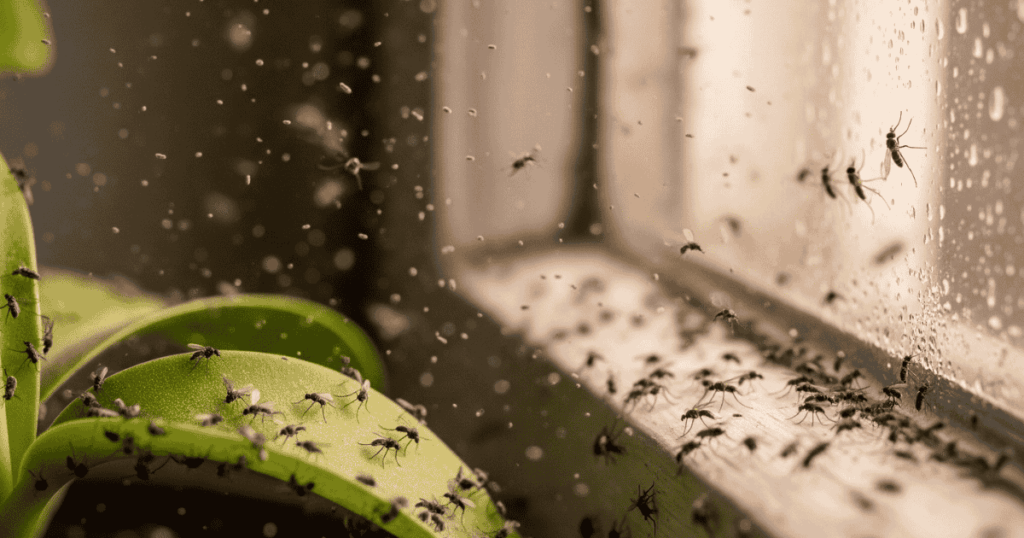
The backbone of how to get rid of gnats is eliminating what causes them to multiply. Gnats need moisture and organic matter to breed and thrive. Here are the top causes:
- Overwatered Houseplants: Fungus gnats lay eggs in damp soil, especially if the soil remains wet for long periods.
- Exposed Food: Fruit flies invade places with overripe produce and sugary liquids left out.
- Clogged Drains: Drain flies breed in moist, organic residue inside plumbing.
- High Humidity: Gnats favor environments where moisture accumulates, such as bathrooms, greenhouses, or crowded rooms.
- Poor Trash Management: Organic waste in garbage cans is a beacon for gnats.
Effective strategies for how to get rid of gnats must address these root causes.
How to Get Rid of Gnats in the House?
Battling gnats indoors means more than just swatting at them, it’s about removing breeding grounds and attractions. Here’s a step-by-step system for how to get rid of gnats in any part of your home.
1. Clean Up the Kitchen and Pantries
- Store fresh fruit in the fridge whenever possible.
- Wipe up spills and sticky areas promptly.
- Seal garbage bins tightly and empty daily.
- Wash dishes soon after use.
2. Tidy Living Spaces
- Remove any organic debris, food scraps, or pet food after meals.
- Clean under furniture and appliances where crumbs accumulate.
- Use airtight containers for sugar, flour, and pet food.
3. Target Damp Rooms
- Fix leaky pipes and faucets quickly.
- Keep bathroom sinks and drains clear of hair and soap residue.
- Ventilate humid rooms, use exhaust fans or open windows.
4. Use Traps
Deploy sticky traps near fruit bowls, plants, and windowsills. Vinegar traps lure fruit flies in kitchens. UV light traps work well in bedrooms or living areas.
Consistent application of these principles makes how to get rid of gnats a routine instead of a battle.
How to Get Rid of Gnats in the Garden?
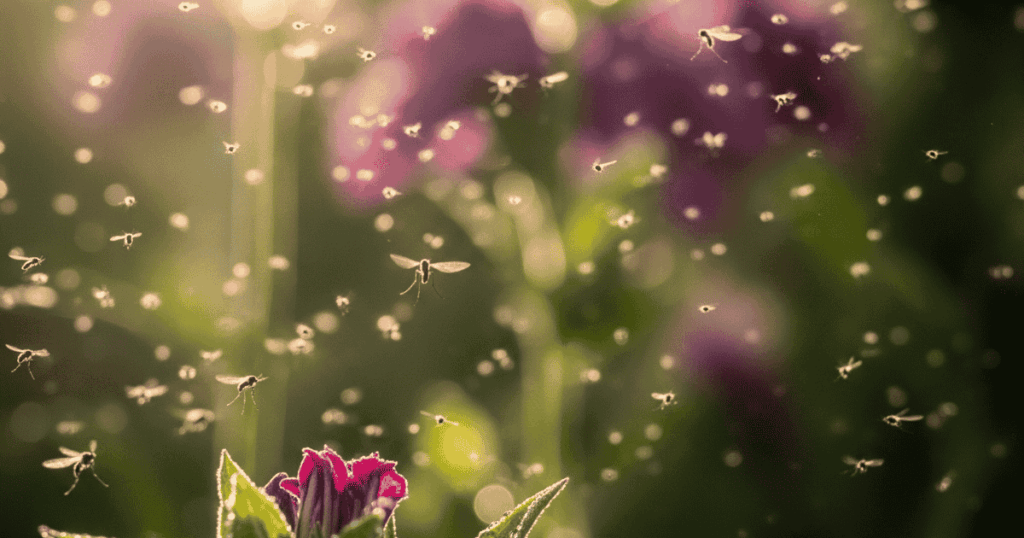
Outdoor gnats pose separate challenges. Here’s how to get rid of gnats in your garden or greenhouse:
- Avoid excessive watering; keep soil just moist, never soggy.
- Remove decaying leaves and plant material regularly.
- Install yellow sticky cards between plant rows and garden beds.
- Use neem oil and garlic sprays on garden soil and foliage.
- Ensure good drainage and sunlight in garden beds.
By following these steps, you’ll discover how to get rid of gnats outside without disrupting beneficial wildlife or your plants.
How to Get Rid of Gnats on Houseplants?
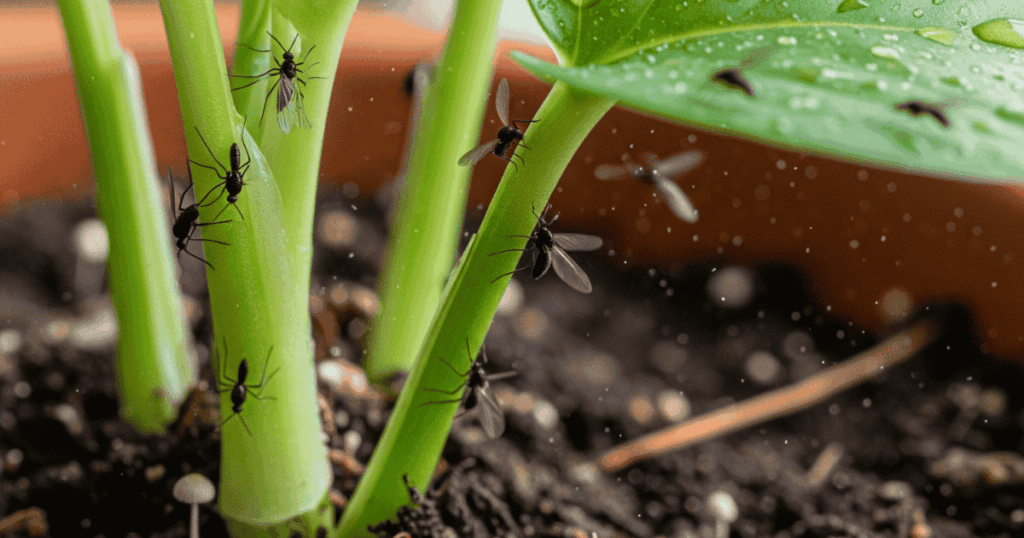
Houseplants are susceptible to fungus gnats. Here’s how to get rid of gnats on your favorite indoor greens:
1. Let Soil Dry Between Watering
Fungus gnat larvae need constant moisture. Allowing the top inch of soil to dry reduces their breeding environment.
2. Add Sand or Gravel
A layer of sand or decorative gravel on top of the soil creates a dry barrier, discouraging gnats from laying eggs.
3. Use Yellow Sticky Traps
Place these near affected plants to catch adult gnats. Sticky traps act as an effective monitoring and control tool.
4. Try Natural Predators
Beneficial nematodes and predatory insects such as Hypoaspis mites can be added to soil to kill gnat larvae safely without harming plants.
These targeted steps ensure how to get rid of gnats around houseplants is sustainable and doesn’t harm your plants.
Houseplant Gnat Control Chart
| Step | Technique | Success Rate | Notes |
| Dry Soil | Limit watering | High | Prevents egg laying |
| Sand Layer | Block access to soil | Medium | Enhances other methods |
| Sticky Traps | Catch adults | High | Use at soil level |
| Neem Oil | Treat larvae/adults | High | Mix per instructions |
| Organic Removal | Clean pot regularly | Medium | Reduces food sources |
5 Ways on How To Get Rid of Gnats Fast?
If you need rapid steps for how to get rid of gnats, try these proven approaches:
- Vinegar Trap: Mix apple cider vinegar and dish soap in a bowl to lure and kill fruit flies.
- Yellow Sticky Cards: Place in critical spots indoors and in the garden for fungus gnats.
- Drain Cleaning: Pour boiling water and baking soda down drains weekly.
- Reduce Watering: Dry out plant soil to break the breeding cycle.
- Garbage Sanitation: Remove trash daily and use tightly closed bins.
| Step | Action | Target Gnat Type | Room Focus |
| Remove Decaying Food | Seal/store perishables | Fruit Flies | Kitchen |
| Dry Out Soil | Reduce plant watering | Fungus Gnats | Living Room, Garden |
| Place Sticky Traps | Trap and monitor adults | All types | Houseplants, windows |
| Clean Drains | Use boiling water/baking soda | Drain Flies | Kitchen, Bathroom |
| Use Vinegar Trap | Attract/kill fruit flies | Fruit Flies | Kitchen |
These tactics dramatically speed up results in how to get rid of gnats for the average household.
Best Traps for Gnats
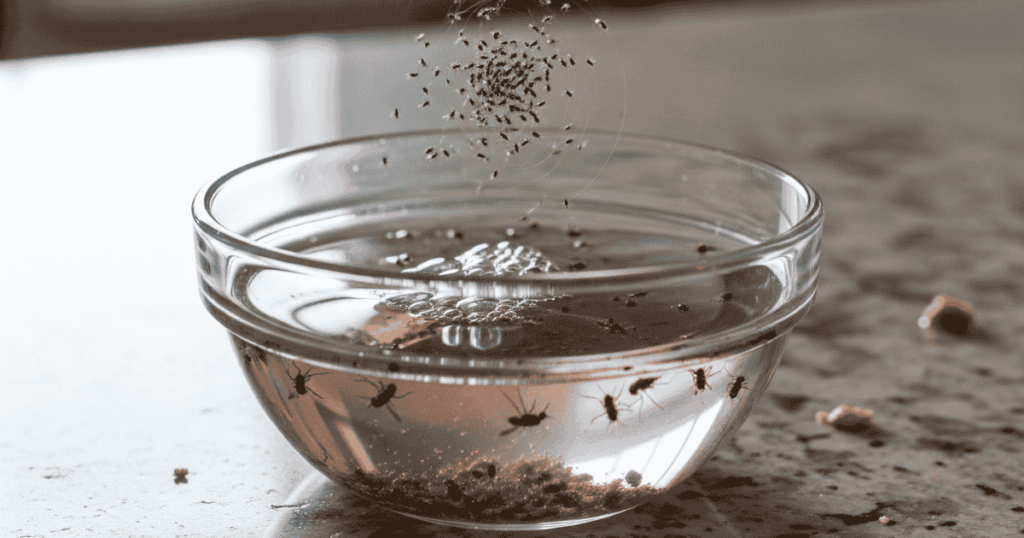
Traps are essential for how to get rid of gnats both indoors and outdoors. Review these favorites:
Sticky Traps
Yellow sticky cards are highly recommended for catching adult fungus gnats and fruit flies. Simply place them near houseplants, fruit bowls, or garden beds.
Vinegar + Dish Soap Trap
Fill a shallow dish with apple cider vinegar and a few drops of dish soap. Cover with plastic wrap, poke holes, and fruit flies will be lured in, fall in, and drown.
UV Light Traps
Plug-in UV traps attract gnats in living rooms, bedrooms, and kitchens, especially effective at night.
Liquid Bait Traps
Disposable traps for fruit flies use an attractant liquid to lure and kill gnats quickly. Great for kitchen counters.
Choose the right trap for your situation, each can be the backbone for how to get rid of gnats permanently.
Gnat Trap Comparison
| Trap Type | Target Gnats | Best For | Pet Safe | Note |
| Sticky Cards | Fungus, Fruit | Plants, Soil | Yes | Replace frequently |
| Vinegar Trap | Fruit Flies | Kitchen, Pantries | Yes | Simple to make, disposable |
| UV Light Trap | All adults | Indoors, bedrooms | Yes | Needs electrical outlet |
| Liquid Bait Trap | Fruit Flies | Kitchen | No | Use as directed |
Natural Home Remedies on How to Get Rid of Gnats?
If you want eco-friendly methods for how to get rid of gnats, these natural approaches are safe, affordable, and gentle:
- Apple Cider Vinegar Trap: For fruit flies and fungus gnats. Combine vinegar with dish soap.
- Sand Layer in Plant Pots: Prevents fungus gnats from laying eggs in soil.
- Neem Oil Sprays: Deter and kill larvae without chemicals.
- Garlic and Cinnamon Soil Treatments: Spread ground cinnamon or garlic in plant soil as a natural deterrent.
- Essential Oils: Use peppermint or lemongrass diluted in water as a repellent. Spray on surfaces or around plants.
These remedies are central to any strategy for how to get rid of gnats without risking pets or beneficial insects.
Natural Gnat Remedies at a Glance
| Home Remedy | Target | Safety Level | Application |
| Vinegar + Soap | Fruit, Fungus Gnats | Very Safe | Bowls/Traps |
| Sand Layer | Fungus Gnats | Very Safe | Cover pot soil |
| Neem Oil | Fungus, Fruit Gnats | Safe | Spray (follow instructions) |
| Cinnamon/Garlic | Fungus Gnats | Safe | Mix in soil |
| Essential Oils | Fungus, Fruit Gnats | Safe | Spray areas or plants |
Chemical and Professional Treatments
Sometimes a serious infestation means you need advanced strategies for how to get rid of gnats:
- Insecticide Sprays: Safe for indoor plants if you use products labeled for home use. Always follow guidelines.
- Systemic Plant Treatments: Soil drenches that target larvae (fungus gnats).
- Drain Cleaning Gels: Designed to break down organic residue and kill larvae in pipes.
- Professional Pest Control: For very large infestations or repeated issues, hiring experts may be the most efficient way for how to get rid of gnats for good.
Use chemicals as a last resort, after natural and DIY options for how to get rid of gnats have been tried.
Tips for Preventing Gnats
Prevention is the best long-term solution for how to get rid of gnats:
- Store fruit and vegetables in sealed containers or the fridge.
- Clean counters, garbage bins, and drains regularly.
- Water houseplants only when the top layer of soil dries.
- Use sticky traps proactively in problem areas.
- Maintain good air circulation in all rooms.
- Repair leaks and manage humidity with dehumidifiers.
Good habits are fundamental for a long-term solution to how to get rid of gnats.
Long-Term Gnat Prevention
| Preventive Step | Application Area | Frequency | Notes |
| Food Storage | Kitchen, Pantries | Daily | Use airtight containers |
| Soil Drying | Houseplants, gardens | Weekly | Check before watering |
| Regular Cleaning | Drains, garbage bins | Weekly | Use natural cleaners |
| Ventilation | All Rooms | Ongoing | Use fans/open windows |
How to Get Rid of Gnats, Once and For All?
True mastery of how to get rid of gnats means integrating identification, targeted traps, prevention, and ongoing vigilance. Here’s the ultimate protocol:
- Identify your gnat species (fungus gnats, fruit flies, drain flies).
- Remove all sources of attraction: food, moisture, organic debris.
- Deploy appropriate traps for immediate relief.
- Use natural or chemical remedies for larvae and persistent adults.
- Clean drains, soil, and garbage thoroughly and regularly.
- Adopt preventive habits to avoid new infestations.
Repeat these steps every time you detect gnats and teach household members so everyone knows how to get rid of gnats, for good.
Conclusion
Gnats are more than just a minor annoyance, they can rapidly take over any indoor or outdoor space. This guide has walked through all facets of how to get rid of gnats, from identification, traps, and natural remedies to chemical treatment and prevention. By layering these strategies, you protect your home, garden, and houseplants for the long run. Most importantly, repeat these proven steps whenever you spot new pests, making how to get rid of gnats an easy and routine process. Adopting these habits ensures fewer infestations and greater comfort at home.
For comprehensive and hassle-free leech removal and long-term pest prevention, trust the professionals at Antipest Office. Visit us at the Antipest Office, Our trained technicians use safe and effective methods to protect your home and business. For service bookings and consultations, call us at +91 9819018398 .
How to Get Rid of Gnats? – FAQs
How to get rid of gnats in houseplants naturally?
Let the soil dry out between watering, use sticky traps, and apply neem oil or cinnamon to deter gnats.
How to get rid of gnats in the kitchen effectively?
Store fruit in the refrigerator, clean up spills, use apple cider vinegar traps, and seal garbage bins tightly
How to get rid of gnats in drains and bathrooms?
Flush drains with boiling water, clean with baking soda and vinegar, and use enzyme-based cleaners to remove organic buildup.
How to get rid of gnats in the garden without chemicals?
Reduce watering, remove decaying plant matter, use sand or neem oil in the soil, and deploy yellow sticky cards.
How to get rid of gnats quickly with home remedies?
Mix apple cider vinegar and dish soap in a bowl, cover with plastic wrap, and poke holes to make an effective trap.
How to get rid of gnats for good and prevent them coming back?
Eliminate moisture sources, clean regularly, store produce properly, and establish good plant care habits.
How to get rid of gnats if natural methods don’t work?
Consider insecticide sprays for plants, drain cleaning gels, and consult pest control professionals for severe infestations.
How to get rid of gnats in pet-friendly ways?
Use non-toxic sticky traps, essential oils like peppermint or lemongrass (diluted), and natural soil treatments.
How to get rid of gnats in compost bins and garbage cans?
Keep bins sealed, regularly remove waste, and clean interiors with vinegar or essential oil sprays.
How to get rid of gnats in different environments?
Identify sources, soil, food, drains, apply targeted solutions, and maintain ongoing prevention habits for each location.

